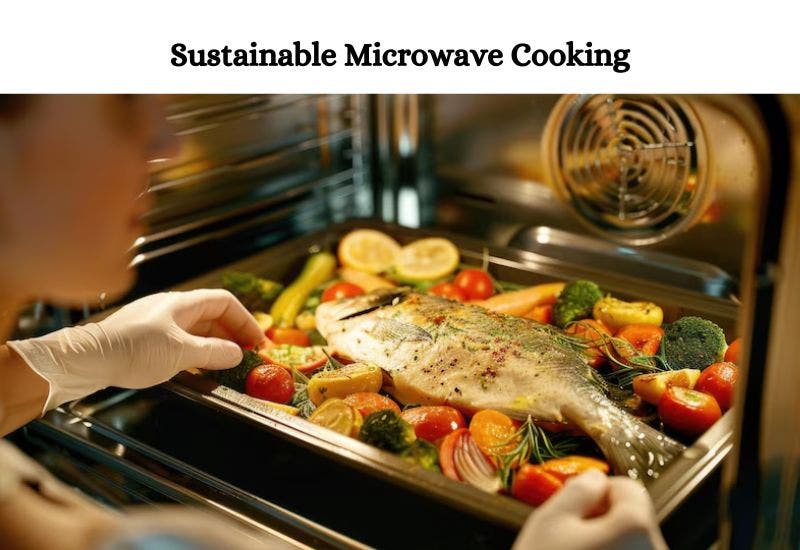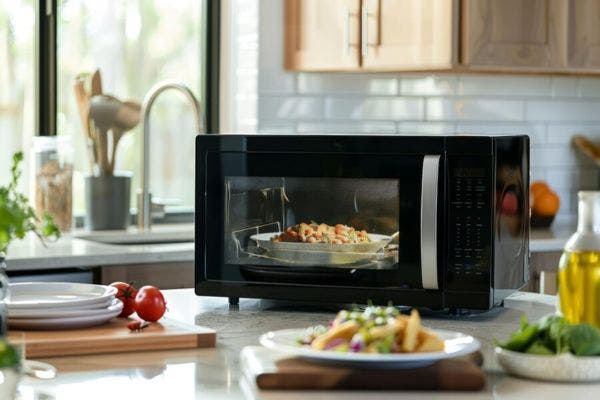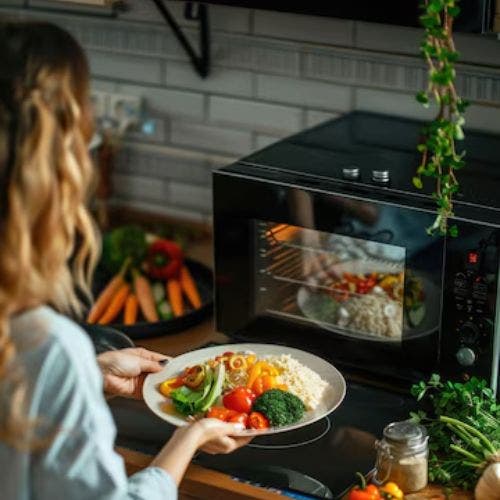Sustainable Microwave Cooking: Eco-Friendly Practices and Recipes


Ever wondered if your microwave is contributing to energy waste? Many people rely on this kitchen appliance without considering its environmental impact. The good news is that with a few simple changes, you can turn your microwave into a more sustainable eco-friendly cooking tool.
By optimizing its use and making eco-friendly choices, you can significantly cut down on energy consumption and food waste.
Getting it interesting and want to learn more about it? In this blog, you’ll find everything. Let’s explore practical solutions to make your microwave cooking both efficient and environmentally friendly.
How to Reduce Energy Consumption in Microwave Cooking?


Reducing energy consumption in microwave cooking is simple. Below we’re going to discuss some microwave energy-saving tips.
Choosing Energy-Efficient Microwaves
First, choosing an energy-efficient microwave can save you money and energy. So, look for models with an Energy Star rating, which uses about 20% less energy compared to standard models.
Besides, check the wattage too. Microwaves with 800-1000 watts cook food quickly and efficiently.
Optimizing Microwave Usage
Did you know that using your microwave efficiently can also cut energy costs? Cook food in batches when possible. Heating multiple items at once uses less energy than doing it separately.
Defrosting food in the fridge first can save up to 50% of the energy compared to defrosting in the microwave. Use microwave-safe covers to trap steam. It’ll help food cook faster and evenly.
Avoid running the microwave empty as it wastes energy and can damage the appliance. Additionally, use the microwave for reheating and cooking small portions, as it uses less energy than an oven for these tasks.
Maintaining Your Microwave for Efficiency
Keeping your microwave clean and well-maintained boosts its efficiency. Clean spills and splatters immediately and check and replace the door seal if it’s worn out. A tight seal prevents heat loss and ensures efficient cooking.
Aside from that, ensure the turntable spins smoothly. A stuck turntable can cause uneven cooking and use more power. Regularly check the power cord for damage and replace it if necessary. Periodically test the microwave's output by heating a cup of water. If it takes longer than usual, it might need servicing.
Utilizing Sustainable Microwave-Safe Materials
Now we’ll show you the ways to utilize sustainable microwave-safe materials.
Selecting Eco-Friendly Containers
Choosing eco-friendly containers for microwave cooking can reduce your environmental footprint. Glass and ceramic containers are excellent options. They are durable, reusable, and safe for microwave use.
Moreover, look for containers labeled as microwave-safe to avoid any risk of chemical leaching. Stainless steel is another sustainable option, but it's not microwave-safe. Avoid plastic containers, especially those not labeled BPA-free. Such containers can release harmful chemicals when heated.
Reducing Dependence on Single-Use Products
Reducing your reliance on single-use products is another effective way to promote sustainability in microwave cooking. Instead of disposable plastic wraps or paper towels, use reusable silicone lids or beeswax wraps.
These alternatives can be washed and reused multiple times. For steaming vegetables, consider using a microwave-safe glass bowl with a lid instead of single-use steam bags. By opting for reusable options, you not only reduce waste but also save money over time.
Strategies to Minimize Food Waste with Microwave Cooking
Minimizing food waste with microwave cooking is easier than you might think. Here are some practical strategies to help you make the most of your ingredients and reduce kitchen waste:
Using Leftovers Efficiently
Microwaves are great for reheating leftovers quickly and evenly. Instead of throwing away small amounts of food, store them in microwave-safe containers for later use. Combine different leftovers to create new meals, such as soups, stews, or casseroles. This not only reduces waste but also saves time and money.
Portion Control
Cooking the right amount of food can significantly reduce waste. Use your microwave to prepare single servings or smaller portions. Try it especially when trying new recipes. Microwave-safe measuring cups and bowls can help you control portion sizes accurately.
Reviving Stale Foods
The microwave can bring new life to stale foods. For example, you can freshen up day-old bread by wrapping it in a damp paper towel and microwaving it for a few seconds. This technique also works for reviving other baked goods like muffins and pastries.
Sustainable Microwave Recipes


Below we’ll show you 3 sustainable low-energy microwave recipes. So, keep on reading.
1. Eco-Friendly Vegetable Stir-Fry
This one is a quick, healthy, and tasty dish, perfect for a light meal or side. Let’s learn how to cook it.
Ingredients
- 1 cup broccoli florets
- 1 cup sliced bell peppers
- 1 cup snap peas
- 1 carrot, sliced
- 2 cloves garlic, minced
- 1 tablespoon soy sauce
- 1 tablespoon olive oil
- Salt and pepper to taste
Cooking Directions
- Place olive oil and garlic in a microwave-safe dish.
- Microwave on high for 1 minute.
- Add broccoli, bell peppers, snap peas, and carrots.
- Microwave on high for 4-5 minutes, stirring halfway through.
- Add soy sauce, salt, and pepper.
- Stir well and microwave for another 1-2 minutes.
- Finally, when it’s done, serve hot.
2. Zero-Waste Fruit Crisp
Here is another delicious dessert that uses leftover fruit. This recipe is perfect for sustainable microwave cooking, reducing waste, and satisfying your sweet tooth.
Ingredients
- 2 cups mixed leftover fruit (apples, berries, peaches, etc.)
- 2 tablespoons sugar
- 1 teaspoon cinnamon
- 1/2 cup oats
- 1/4 cup flour
- 1/4 cup brown sugar
- 1/4 cup butter, melted
Cooking Directions
- Place mixed fruit in a microwave-safe dish.
- Sprinkle it with sugar and cinnamon, and mix well.
- In a separate bowl, combine oats, flour, brown sugar, and melted butter.
- Spread the oat mixture evenly over the fruit.
- Microwave on high for 8-10 minutes, until the fruit is bubbly and the topping is golden brown.
- Let it cool for a few minutes before serving.
3. Leftover Rice and Veggie Bowl
This is a simple and tasty way to use up leftover rice. This recipe is perfect for sustainable microwave cooking and a quick, healthy meal. Let’s explore organic microwave meals.
Ingredients
- 1 cup leftover rice
- 1/2 cup mixed vegetables (carrots, peas, corn, etc.)
- 1 tablespoon soy sauce
- 1 teaspoon sesame oil
- 1 green onion, sliced
- Salt and pepper to taste
Cooking Directions
- Place leftover rice and mixed vegetables in a microwave-safe bowl.
- Add soy sauce and sesame oil, and mix well.
- Microwave on high for 2-3 minutes, stirring halfway through.
- Season with salt and pepper to taste.
- Top with sliced green onion and it’s done.
Practical Tips for Eco-Conscious Microwave Cooking
If you’re not a pro in using microwave cooking here are some practices that you may find helpful.
Choose the Right Cookware
Using the right cookware can make your microwave cooking more eco-friendly. Opt for reusable, microwave-safe containers made of glass or ceramic. These materials are durable, and safe, and reduce the need for single-use plastic or paper products.
Plan Your Meals
Planning your meals reduces food waste and energy consumption. Cook only what you need and use your microwave to reheat leftovers. Batch cooking is also a great strategy. Prepare large portions and store them in individual servings for easy reheating.
Use Microwave Covers
Using microwave-safe covers or lids helps food cook more evenly and efficiently. Covers trap steam, which speeds up the cooking process and reduces energy use. Reusable silicone lids or microwave-safe plate covers are great alternatives to disposable plastic wraps or paper towels.
Optimize Cooking Times
Knowing the optimal cooking times for different foods can save energy and improve microwave efficiency. Overcooking wastes energy and can ruin the food. Follow recommended cooking times and use the microwave's power settings to cook food at lower power when possible.
FAQs
1. Is a microwave sustainable?
-A microwave can be sustainable if used efficiently. Choosing energy-efficient models, optimizing usage, and minimizing food waste contribute to reducing its environmental impact. Regular maintenance also enhances its sustainability.
2. Is microwave cooking energy-efficient?
-Yes, microwave cooking is energy-efficient. It uses less energy than conventional ovens by heating food quickly and directly.
3. What is the best microwave oven in Bangladesh?
-You can’t specify any best microwave as different products are invented for different purposes. However, 2 of the best microwave ovens are the Samsung Convection Microwave Oven and
the eco+ Microwave Oven. For more suggestions, you can check the House of Butterfly.
4. How much is a Microwave in Bangladesh?
-Different microwaves come with different prices. It mainly depends on the capacity. For example, the Whirlpool Solo Microwave (20 LITER) costs around 11500 BDT. Again, for a higher capacity, the LG Charcoal Microwave Oven (32 LITER) is better and costs around 47500 BDT.
Conclusion
That’s all about the topic. In this article, we’ve explained how to choose energy-efficient microwaves, optimize their usage, and maintain them for better performance, and other related things.
Now, it’s your turn to implement these tips and follow the green cooking practices. Remember, by making small, eco-friendly changes to your cooking habits, you can significantly reduce your environmental impact. So, let’s make microwave cooking greener and more sustainable, one meal at a time!

